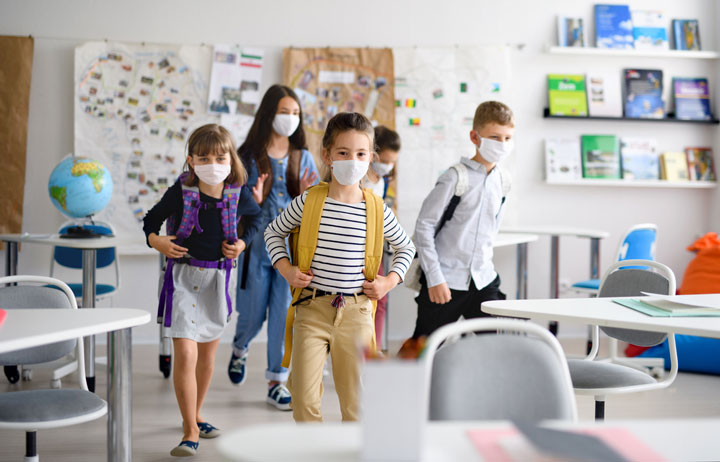The newest CDC guidance: Operational Strategy for K-12 Schools through Phased Mitigation Updated Feb. 12, 2021, is hot off the presses and under intense scrutiny. I admire the leadership of CDC Director, Dr. Walensky, but I am confounded by the lack of urgency for school staff to be vaccinated as a priority to reopen schools safely. The game-changer will be access to COVID vaccines for school staff and eventually students because it will infuse a sense of safety. Layered upon known mitigation strategies, having vaccinated staff will also quell the fears and anxieties of parents and staff.
Can we finally use our public health megaphone and yell from the rooftops that COVID is airborne? Why aren’t we? Is it too consequential to share the truth about what it means that this virus and its variants hang in the air for hours? What does this mean for school? And please do not tell us to double mask because that tells me that you have not spent hours upon hours in schools.
Here is one of the most helpful Twitter threads I have read about airborne virus guidance:
What is missing from this CDC school reopening priority list? Airborne virus guidance! Like almost nothing in 33 page document on ventilation except 1 paragraph on open the windows, but only if feasible. Ventilation should be #2 behind masks! #COVID19 https://t.co/WrHVbv1ftr pic.twitter.com/WA2T2yDkVN
— Eric Feigl-Ding (@DrEricDing) February 12, 2021
The idealized requirements that the CDC lays out in the latest guidelines would require a Disney-like response of audacious cooperation, funding, and community buy-in. In the real world of my urban, under-resourced school district that is facing forced closures of four more public schools, this is pie in the sky, to say the least. Let’s bring the guidelines down to the ground level where families and school staff live and work.
The underlying need is safety, both physical and psychological. School has not felt safe for some time. Hyper-realistic active shooter drills, community gun violence, and school shootings have exposed millions of students to traumatic stress in a pre-COVID world. Add a pandemic and almost a year of a world turned upside down, no wonder we feel like every day is Blursday and safety feels untenable.
The heavy reliance on schools to provide contact tracing and managing caseloads of students and staff that are quarantining and isolating must end. Schools are running on fumes, school nurses are overwhelmed with enforcing public-health mitigation strategies and scrambling to keep up with ever-changing guidelines, on-going contact tracing with many parents and community members refusing to cooperate with the necessary questions. We do not have the infrastructure to implement the idealized guidelines that sound amazing on paper but may not translate where they count, at school. Many schools have given up trying to manage contact tracing for these reasons.
Is there financial support to have public health professionals embedded in school districts? This may be the only way to manage the full scope of contact tracing in schools. Continuing to thrust it on the shoulders of school nurses or school administrators is not feasible without proper staffing. Twenty-five percent of schools across this country have no school nurse, 35% have only part-time coverage and 40% have full-time school nurses, many with high student ratios. For the many schools that are already fully open or in a hybrid capacity as well as remote, the burden of contact tracing has been with school nurses. This is in addition to the other equally important and consequential professional services that school nurses provide in a non-pandemic environment.
I was encouraged to read about weekly COVID testing in schools, but once again, we need to partner with community healthcare providers who can establish a regular testing routine. Ideally, home testing, once available will be preferred due to the sheer volume, staffing, and space needed to conduct testing safely, efficiently, and expediently.
The overarching message of the CDC guidelines is that schools, local health departments, community partners, parents, guardians, school staff, students, and school nurses must join together to enforce layer upon layer of safety strategies to keep everyone safe. I appreciate the level of detail but wonder about implementation. I am committed to being part of the solution to return to school in an environment that is supportive, safe and creates the sense of community so many have missed for almost a year.

Robin Cogan, MEd, RN, NCSN is a Nationally Certified School Nurse (NCSN), currently in her 20th year as a New Jersey school nurse in the Camden City School District. She serves on several national boards including The American Foundation for Firearm Injury Reduction in Medicine (AFFIRM), a gun violence prevention research non-profit organization and the National Board of Certification for School Nurses (NBCSN). Robin is the Legislative Chair for the New Jersey State School Nurses Association (NJSSNA). She is proud to be a Johnson & Johnson School Health Leadership Fellow and past Program Mentor.
She has been recognized in her home state of New Jersey and nationally for her community-based initiative called “The Community Café: A Conversation That Matters.” Robin is the honored recipient of multiple awards for her work in school nursing and population health. These awards include 2019 National Association of School Nurses (NASN) President’s Award; 2018 NCSN School Nurse of the Year; 2017 Johnson & Johnson School Nurse of the Year; and the New Jersey Department of Health 2017 Population Health Hero Award. Robin serves as faculty in the School Nurse Certificate Program at Rutgers University-Camden School of Nursing, where she teaches the next generation of school nurses. She was presented the 2018 Rutgers University – Camden Chancellor’s Teaching Excellence Award for Part-time Faculty.
Robin writes a weekly blog called The Relentless School Nurse. You can also follow her on Twitter at @RobinCogan.



















2 Comments.
Teachers are people too, as are nurses — with families and lives away from work. This seems to be a forgotten fact among the public. My parents were elementary school teachers for years and they brought home every single illness and cold and virus that the students and other staff brought to school.
This past December, my granddaughter’s kindergarten teacher caught COVID right before winter break. No one else in either morning or afternoon cohort, to our knowledge, was affected. HIPAA laws and the privacy and secrecy made it a huge rumor mill as to who had experienced the COVID until the teacher allowed the information to be given out. Thankfully, she had a mild case and returned to school in January. School was closed for those last couple of days and it was unclear if they would reopen after the break. (They did). NOTE: Only K-8 public school students are in school 2-3 hours a day in my locality. The high schools were not equipped with hepa filters and proper revamped ventilation nor the ability to social distance. They will return next week – 2 days a week for 2-3 hours. How long this will last is unknown.
The point is — where did the teacher catch it? We don’t know of any of the children having it, but did they inadvertently carry it to her? Or did she catch it through her own community, family and activities? We won’t know because of HIPAA. And extremely poor public health tracking and tracing make it nearly impossible to know much.
Schools are a huge pot of germs! And whether or not statistics support the theory that this situation is dangerous to the children, it IS dangerous to all of the adults in the schools! If we’re going to have a chance of reopening schools and keeping them open we need to vaccinate teachers and other schools staff BEFORE we reopen. Cases are slowly ticking back up — we are not safe yet!
Thank you for saying what so many of us are thinking!